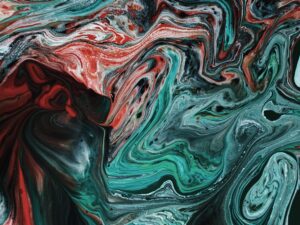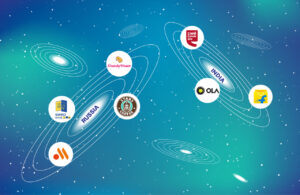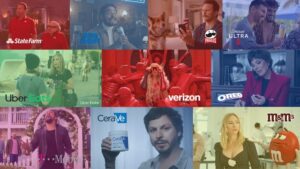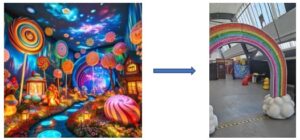2024 Prediction #1 A Year of Chaos–Change for the Worse AND Change for the Better

2023 was grim. Wars, climate disasters, political and cultural polarization. We see no end to this. The disruption will continue and get worse in 2024.
We have moved out of the era of Chronos time, after over 100 years. This was predictable time marked by the steady ticking of the clock, movement forward, step by step. A time when progress was taken for granted. We are now living in Kairos time, chaos time, a time of constant change, where time ebbs and flows, backwards and forwards, round, and round. A time characterized by eruptions – wars, fires, volcanoes, floods, political extremism, insurrections, cultural battles, laws overturned.
Foundation for positive outcomes
But other things are also happening. They started in 2023 and have laid a foundation for positive outcomes, in 2024 and much longer-term. Here are some of them:
- Artificial Intelligence, with its potential to be not just as a source of fake news, but an enhancer of all human activity, to end the grind of meaningless, repetitive tasks and free people up to focus on the ideas and innovations which we are best at.
- CRISPR technology, bringing cures for sickle cell disease, which has tormented whole populations for centuries. A slew of new drugs to treat obesity, which today shortens the lifespans of almost half the world’s population.
- New, clean, and green sources of energy – electrification, hydrogen, solar, renewables are transforming not only vehicles but just about everything: all industries, how we heat our homes. They are in their infancy, as we can see from the way fast-draining electric vehicle batteries and lack of charging stations are stranding drivers in cold weather. But carbon emissions have already gone down significantly for many countries.
- New forms of transportation which can open the universe to us—not just autonomous driving but flying cars and access to space travel.
- Augmented reality, which is not a fad, as the metaverse seems to be. Mark Zuckerberg must be regretting his decision to rename his company Meta and bet his future on it. Augmented reality is of limited use to us now, with clunky headsets, most recently from Apple, priced at $3,000. But it has the power not only to create experiences which heighten our enjoyment, but to replace slow and expensive physical processes such as crash testing for cars and shelf layout planning for retail stores.• New forms of payment, from digital wallets to cryptocurrency, which, despite the excesses of SDF, crypto’s appeal to organized crime, and horrendously energy consuming bitcoin mining, are transforming how money moves and maybe even who controls it. Banks will cease to be quite so archaic; cash is disappearing. Even beggars are using Venmo.
- New ways of farming, as different forces collide for the better. More sustainable farming. Digital tools to tell you what to plant when and where, across every corner of your property. CRISPR tools to develop more disease and drought-resistant crops. Increased biodiversity, with the introduction and reintroduction of multiple new and revived varieties and breeds.
- Most importantly of all, new generations are emerging, who care about what matters not just for themselves but for all of us—who demand transparency, and won’t tolerate corruption, waste, and bad behavior.
How disruption will impact marketing and brands
What does this mean for brand and marketing? The disruption of every part of it. Will some jobs go? Yes, but they will be replaced by other, more meaningful ones.
The demand for branding will continue to grow.
More and more new brands will emerge and use new technologies to take over whole industries from long established leaders. The leaders of the digital revolution which lies behind most of these changes have already replaced the General Electrics, DuPonts and Exxons of this world as the world’s most valuable brands and businesses. The Tesla brand is worth more than the nine traditional car companies combined – dwarfing the value of General Motors, Ford, Toyota, and Volkswagen.
Old brands will continue to split, merge, and rethink themselves, to adjust to this new world, as existing ways of doing things become obsolete. If they don’t, they will simply disappear. We’ve already seen the emergence of Haleon from GSK, Kenvue from Johnson & Johnson, three brands from the ashes of Dow and DuPont.
New tools will transform the creative process and go-to market approaches. AI is already being deployed in content development and image creation to enhance copyediting and design. It is enabling faster and better scaling, content development, targeting.
Here’s what a quick search will tell you (no need to resort to ChatGPT). MasterCard is using AI to create content at scale. Harley-Davidson is using AI to improve online ad performance. Citrix is using AI to predict which marketing efforts will be successful. P&G is using AI to extract actionable insights from data. Nestle is using AI to create better performing content. Starbucks is using predictive analytics to increase average order value. Unilever is using AI to conduct market research.
The most powerful changes are not about cost cutting but improving quality and effectiveness. We are gaining the ability to customize not only to each individual but across each step in the customer journey and every touchpoint of the brand experience. The merging of the digital and physical will deliver more exciting and rewarding experiences. Burberry has done more than just about any brand to integrate digital into its stores and delivering authentic, augmented reality online experiences.
And we will see marketing democratized now that everyone can access the tools to create and influence. This is already happening with the growth in impact and reach of not only celebrity influencers, but any micro-influencer who strikes a chord. Eos’s most successful recent ad campaign used an in-your-face video put out by a brand fan on TikTok.
So, the major change we will see in 2024 is positivity emerging from the darkness, a trend towards progress, good changes germinating from the seeds sown in 2023. There has never been more opportunity in marketing. It’s a wonderful time for anyone to join the profession.
2024 Brand Prediction #2 Brand nationalism—The formation of brand galaxies

The rise of brand nationalism
Brand nationalism is growing in our increasingly multipolar world.
Not since the end of the Cold War has the geopolitical stage witnessed such a dramatic reshuffling of power. The world is now firmly multipolar, with several power brokers vying to shape the new order, coalesce ecosystems, influence culture, and dominate trade. Nationalism is expected to continue its spread as more than 40 countries go to the polls in 2024, the largest number of people voting in history. The era of hyper-globalization has now been replaced with “slowbalization” or “localism.” Slogans such as “America first”, “China first”, “India first”, or “Russia first” are shaping trade and economic strategies.
These forces are creating parallel economic worlds, each with their own galaxies of brands. Increased protectionism, unreliable global supply chains and rising populist sentiment mean that consumers in each of these ecosystems are going about their lives surrounded by brands unique to their own world. Brand nationalism means that travelers moving from one regional vortex to another will find themselves in a different multi-verse of brands.
The growth of local brands—India
Take India, for example. If you are dropping into this world from the West, you will certainly see Starbucks, Uber, and Amazon, but these brands won’t dominate the landscape. Instead, you won’t be able to miss Café Coffee Day, Ola and Flipkart. According to a recent survey, 60% of Indian consumers across all age-groups are seeking to replace foreign brands with indigenous brands, and 41 per cent are even willing to pay a premium for them. The government is supporting local brands in an effort to reduce imports with initiatives such as Atmanirbhar Bharat (self-reliant India), Make in India, and Vocal for Local.
The growth of local brands—Russia
In Russia, this process has been accelerated by force of circumstances. As Western brands have pulled out, and Putin’s propaganda has become ever more vociferously hostile towards the West, Russian brands have rushed in to fill the gap. Lookalike brands include Swed House offers products almost identical to those of IKEA. It has signed contracts with IKEA’s former production sites. McDonald’s has given way to Vkusno & Tochka (Tasty Period). Krispy Kreme has been replaced by Krunchy Dream; Lush by Oomph. Starbucks has been supplanted by Stars Coffee, whose social media bio reads “the bucks have left, but the stars remain.” These new brands are still much smaller than their predecessors. Swed House employs 100 people among 10 shops, but plans to double the number this year. As Alexandra Prokopenko, of the Carnegie Russia Eurasia Center says, “what’s happening is a kind of nationalization of the Russian economy.”
What brand nationalism means for global brands
Brand nationalism must figure into the plans of any brand with ambitions to play in a different brand galaxy. They will need to adapt their offerings and messages to fit the national zeitgeist. The idea of localization is not new. But what is new is the greater weight of patriotic fervor, antipathy towards other world powers, and indignant resistance to a global brand invasion. To counter this, global brands must try to instill a sense of belonging and community, source locally available raw materials, partner with local distribution channels, and communicate all this to consumers. And they must continue to offer local variations of products, like McDonald’s with Turmeric Latte and Masala Kadak Chai in India, McCurrywurst in Germany, Teriyaki McBurger in Japan, and the McFalafel in Egypt.
These brand galaxies are becoming breeding grounds for creating and launching of these local brands back out into other regions. As brands grow and mature within each of these parallel vortexes, they eventually reach the scale and ambition to invade other worlds. One such example is China, and our next piece investigates the brand nationalism trend there in more depth.
2024 Brand Prediction #3–Chinese Brands Go Global

Chinese brands with global appeal are the goal. It has been 10 years since the Chinese government declared its intention to help Chinese companies build global brands. Its reasoning was simple. Chinese businesses were booming. China had become the world’s factory. But Chinese companies produced shoddy goods and China gained a global reputation for being only capable of creating cheap, low-quality products.
Chinese manufacturers mostly worked as subcontractors for foreign companies, like Foxcom for Apple. These companies put their western brand names on the Chinese-made products and sold them at premium prices. When Chinese companies manufactured identical, or almost identical wares, and put Chinese brands on them, consumers, both global and Chinese, disdained them. Even at a fraction of western brand prices, Chinese brands struggled to find a market.
In 2014, the Chinese government adopted a strategy of investment in domestic innovation, called the “Made in China 2025” initiative. This included the launch of a new government department—the International Academy of Brand Science. They have persevered doggedly with it ever since. The Institute’s task is to encourage brand building by Chinese companies and teach them how to do it. This is a bit the case of the blind leading the blind – it’s part of the Chinese government bureaucracy after all.
The emergence of local Chinese brands
But, step by step, things have been improving for Chinese brands. Circumstances have helped.
In China, consumers now have a better standard of living and more money to spend. They are looking for higher quality products, regardless of origin. By cutting China off from the rest of the world, COVID forced consumers to turn to what was available locally. Government actions and geopolitics have helped immensely. Trade wars, the consolidation of power by Xi, clamp down on Hong Kong, disputes over Taiwan and the South China Sea, mounting friction with the US and Europe not only over trade, but over national security, Chinese espionage and hacking, and Russia’s invasion of Ukraine have polarized the world and led Chinese consumers to see the West as hostile. A new trend has emerged, ‘Guochao’ (national pride).
Local brands have upped their game. They’ve improved their quality and entered the luxury market. They’ve learned how to market astutely, and in ways that fit the domestic market better than global rivals – adapting products to Chinese culture and responding faster to local trends.
BrandZ says that the top 100 brands in China have grown their value 265% since 2014 and are now worth over $1 trillion. Chinese brands now dominate lists of the top brands in China. Domestic labels’ share of the 40 top beauty brands’ China online sales rose to 50% in 2023. The fastest growing, Huaxizi (Florasis), hugely popular among China’s Gen Z, was launched in 2017, and already has sales of almost $1 billion.
Huaxizi—a Chinese beauty brand
How have local Chinese brands done this?
By integrating classical Chinese stories and aesthetics into its stories, incorporating wisdom from ancient Chinese on the use of plants, flowers, and animal fats to change appearance and basing whole product launches on traditional Chinese stories.
By reacting swiftly to local trends. Huaxizi and other local brands were quick to start marketing on Douyin, TikTok’s Chinese app. It reaches a much wider audience of young consumers than traditional e-commerce channels, and uses local celebrities and influencers. Western companies, such as L’Oréal didn’t catch up with the trend. According to the Financial Times, if the local cosmetic brands, Judydoll and Joocyee, spot a lipstick shade that is losing momentum or a new trend that is about to take off, they can adjust the production within a month, compared to western brands which take 4-6 months to respond.
Chinese brands go global
We are about to see a major surge of Chinese brands onto the global market. There have always been some—Lenovo was an early example—but they were few and far between. Two brands spurred the momentum—TikTok and Shein. TikTok, owned by ByteDance, has surpassed Facebook to become the world’s most downloaded app, used by a third of US adults, 43% of whom get their news from it. Shein, originally known as ZZKKO, has swept the globe with its ‘fashion forward designs, endless assortment, and dirt-cheap prices.’ Launched in 2008, it is now the world’s largest fashion retailer, with over $30 billion revenues, and is planning a New York IPO.
The Chinese brand explosion looks about to really take off in 2024. The reason – electric vehicles. China is now way ahead. BYD (Build Your Own Dreams) makes cars that are ‘snazzy, whizzy and cheap’. It is the largest car maker in China and overtook Tesla globally in the fourth quarter of 2023 with sales of 526,000 vs. Tesla’s 484,000. China’s total car exports were 5 million in 2023. China is forecast to double its share of the global automotive market to 1/3 by 2030, overtaking Japanese, American and German car brands. The value of the BYD brand is already estimated at $10 billion.
The Super Bowl sent the signal. Temu, owned by the Chinese e-commerce giant Pinduoduo (PDD Holdings), is spending money like water to create awareness and sales in the US. Its Super Bowl ad, showing animated people shopping like billionaires for 99 cents, aired 5 times at $7m a pop, and was completely inescapable.
Meanwhile, the Chinese government’s investments in brand building are gaining traction. China is the most active participant in the ISO committee which has published the first global standards for brand valuation and evaluation. It has big plans for 2024, including a ‘Global Brand Day.’ This is a souped-up version of the China Brand Day which it launched in 2017 at the Shanghai World Expo. Events are planned not only in China, but also at the UN in New York. It’s already true that to have a brand that’s respected in China, you must have a billboard in Times Square. If you go, you’ll see lots of them.
What does this mean for marketers?
The coming of global Chinese brands signals an end to US global brand dominance. The Chinese trajectory with global branding will follow the classic disruption curve—start with products that are lower priced and at the lower end of the quality range, then move up, becoming more premium, step by step. It’s not just the US that will be affected. French and Italian luxury brands should watch out. South Korea has already made big inroads into the beauty market. China will follow.
We believe this is a good thing for branding. As brand acumen becomes more distributed and centers of brand excellence arise in former developing markets, this will multiply the variety and richness of brand experiences, reflecting different origins and cultures. China is on the fast track. We can expect global Latin American, Middle Eastern and African brands will follow.
2024 Brand Prediction #4–Will use of celebrity endorsement in marketing campaigns kill creativity?

More brands are using a celebrity endorsement in their marketing and advertising campaigns. While celebrity endorsers seem like a safe option, the growth of celebrity marketing campaigns puts a damper on creativity.
Celebrity endorsements have the power to attract attention
Celebrities have some of today’s most valuable brands. They have always been able to command a strong hold over our imaginations, from Charlie Chaplin and Greta Garbo to Bonnie Prince Charlie, Napoleon, and Princess Diana, to Jack Welch and Steve Jobs, Babe Ruth, David Beckham, Ronaldo, and the Beatles. But it’s never been anything like it is today. The cause – social media and its ability to make celebrities ubiquitous and coverage of their actions instant.
Celebrity brands wield enormous power. They can draw our attention away from just about anything. Viewership of the Super Bowl dramatically dipped after Beyoncé made a surprise announcement of a new record release and people turned off their TVs to go and look for it. They command armies of followers, who imitate everything they do and start new fashion trends. Taylor Swift has single handedly popularized cowboy hats; Olivia Rodriguez 90’s grunge fashion and purple hair; Beyoncé metallic sparkle, glitter, and barely-there body suits; and of course, Steve Jobs chinos and black turtlenecks.
Celebrities are no longer mostly pop stars and film stars. They’ve replaced just about every kind of brand in just about every category.
Fashion is no longer focused on Dior, Chanel, or Gucci, as much as the designers who represent them. Shoppers follow them from brand to brand—Maria Grazia Chiuri from Valentino to Dior, Sabato de Sanro, from Valentino to Gucci, and Phoebe Philo, famous for her transformation of Celine, to her own brand where she is now creating instantly sold-out collections.
Restaurants are no longer about the locations, but the celebrity chefs who cook in them (or, increasingly, own multiple restaurant brands)—Daniel Boulud, Gordon Ramsay, Jamie Oliver, Guy Fieri, and many others.
Business news zooms in on famous CEOs, as much as the companies they run—from Elon Musk and Mark Zuckerberg to Satya Nadella at Microsoft, Sam Altman at OpenAI, and now Mika, the first AI robot CEO.
Politics is now all about personalities. Attention on the US election is zeroing in on Trumps lawsuits and Biden’s age, not the policies of Republicans or Democrats. Russia is Putin, Ukraine Zelensky.
Celebrity brands make money—for the celebrities
And celebrity makes money. Far more money than ever before. Think of Taylor Swift’s last concert series, which generated more than $1 billion in ticket sales.
A major reason for this is that celebrity brands are transferrable across categories.
Some of the most popular and profitable beauty brands have been created by celebrities—Fenty Beauty by Rihanna had sales of over $1 billion in its first year. Music stars have migrated to fashion, creating their own brands, and being hired by famous fashion houses—Rihanna now has her own label at LVMH, Pharrell Williams has been hired as creative director of menswear for Louis Vuitton.
Celebrities have their own restaurants and food businesses. Paul Newman started it with Newman’s Own, salad dressings and sauces.
Beginning with Ronald Reagan, screen stars have entered politics—Arnold Schwarzenegger from body builder to governor of California, Zelensky from a TV comedy show to President of Ukraine. And, of course, Trump would never have got into the White House, if it wasn’t for his reality TV show. His income has come from brand licensing, not owning real estate.
The boundaries between music, fashion, art, food, and politics are fast disappearing.
Celebrity endorsements can make money—for others
Companies have seen all this. They have stampeded after celebrity endorsements. Association with a celebrity influencer can bring demonstrable business advantages.
A celebrity endorsement can increase brand awareness. Celebrities are some of the most powerful influencers, with have large fan bases and huge social media followings. Their actions attract public attention, which can instantly boost a brand’s visibility and reach a wider audience.
Partnership with a celebrity influencer can enhance brand image. Celebrities can positively influence perceptions by associating a brand with their own attributes, such as success, popularity, or specific values. For example, Emma Watson’s passion for sustainability casts a positive halo over fashion brands. An athlete endorsing a fitness brand in its marketing campaigns can increase its image of being athletic and healthy.
Celebrity endorsements can be used for targeted marketing. Brands can leverage a celebrity’s image to reach a specific demographic or target market.
Relationship with a celebrity creates familiarity, credibility, and trust for a brand, leading to increased sales and customer loyalty. Nike saw an 800% increase in basketball shoe sales in the first 3 years of its partnership with Michael Jordan. During Pepsi’s collaboration with Beyoncé (2003-16) PepsiCo’s revenues grew from $29 to $63 billion. Mint Mobile’s revenue grew 50,000% in 3 years following its promotion by Ryan Reynolds and led to its acquisition by T-Mobile for more than $1 billion in 2020.
There are risks but the benefits outweigh the risks. Celebrity faux pas are few and far between. And celebrity influencers bounce back. Look at John Galliano, fired from Dior for his antisemitic remarks, now creating a storm at Maison Margiela. Kanye West (now Ye) lost his partnerships with Adidas and other brands, after he declared his love for Hitler, but he’s now back with a #1 album.
Brands should stop overusing celebrity endorsements
It has gone too far. 58 ads aired during the 2023 Superbowl. Almost half of them featured celebrities. The onslaught of famous faces was relentless, from TV and movie actors such as Edie Falco, Ben Affleck, Scarlett Johansson, and Arnold Schwarzenegger, to music stars Cardi B, Ice Spice, Usher, and Beyoncé to top sports players, including Peyton Manning, Tom Brady, and Wayne Gretzky. Some had a whole lot of celebrities—Jennifer Aniston, David Schwimmer, Usher, the Beckhams, and Jelly Roll all appeared in ads for Uber Eats.
The result of this overkill? A celebrity endorsement is ceasing to be a differentiator. The parade merges together. Celebrity marketing campaigns won’t generate longer term recall for any brand. The situation is even worse in India, where brands exploit the fascination with celebrities year-round, not just during the Cricket world cup. Movie and sports stars appeared in almost 30% of all TV ads in 2023. The Bollywood actor Amitabh Bachchan alone endorsed 53 brands, ensuring that his fame would not be associated with any of them.
Why are brands prostituting themselves in this way? It’s risk avoidance. Celebrity endorsements can be shown to make money. Using celebrities in marketing campaigns is something CEOs and CFOs can understand. Much easier to explain and justify than great creative advertising, which breaks norms and takes risks. There’s also an element of the herd instinct – one brand does it, its competitors feel they have to follow.
Celebrity brands have the power to attract attention
The craze for celebrity endorsements will reduce creativity and negatively impact brand building. Celebrity marketing campaigns are effective only when there is an authentic match between the celebrity’s values and those of the brand. Think of Schwarzenegger’s environmental activism and his partnership with Tesla. George Clooney’s sophisticated image and global recognition make him the perfect ambassador for international luxury coffee brand, Nespresso. In their quest for immediate sales, companies have recklessly abandoned the idea of association with celebrities who fit their brand. The effect will be to diminish advertising’s long-term impact, reduce ROI and destroy brand value.
There are signs that social media audiences are tiring of celebrity influencers. Hopefully the current brand obsession with celebrities will also wear itself out.
2024 Brand Prediction #5–The impact of AI marketing will be positive

Marketers are polarized about the impact of artificial intelligence on the marketing discipline. We believe the positives of AI marketing will far outweigh the negatives. In 2024, AI will become a widely accepted tool for marketers.
AI marketing hallucinations
There’s no denying that we have seen some AI marketing failures of epic proportion recently.
What people saw on social media vs. What they saw when they turned up

An events company in Glasgow got carried away using generative AI to create fantastical images of a Willy Wonka factory, promising customers a magical in-person experience where “chocolate dreams become reality.” When people showed up, what they saw was pathetic—some lame decorations, and a sad actor pretending to be an Oompa Loompa in a deserted warehouse. Irate customers called the police, the disaster went viral, and social media has branded the event as “Scotland’s Frye Festival.” The worst part? No chocolate at the event!
Microsoft’s Bing chat service recently told a New York Times reporter that he would be better off leaving his wife. Air Canada’s chat bot erroneously promised a customer a refund, which the company refused to pay, but was ultimately forced to honor, following humiliation on social media and legal action.
The negatives of AI marketing are over-emphasized
Such high-profile incidents have fueled the skepticism towards AI marketing. Many of the issues are serious and the marketing profession will need to address them as it continues to embrace AI.
Biases inherent in the training data set for AI models could lead to discrimination in marketing. For example, Google’s GenAI app Gemini found itself in the crosshairs of the culture wars when it refused to generate images of white people, presenting only Black and Asian Australians, equated Hitler with Elon Musk, and labeled Indian Prime Minister Modi’s policies as “fascist.” The tech giant has apologized for some of these gaffes, and pledged to retrain its AI engines. The problem was that Google had inserted a diversity instruction to compensate for the fact that AI finds more pictures of white people on the web than other ethnicities. The issue of biases is a solvable one.
Marketers also lament that messaging created by AI marketing lacks the human touch and fails to engage as effectively as human-created communications. Further, differentiation is at risk since any brand can use AI. However, in a recent study, consumers preferred AI-generated content to human-generated by 54% vs 46%. AI marketing will continue to improve and generate messaging that is as engaging as human marketing. But when it comes to overall brand strategy and positioning, AI marketing will not replace human marketers. The human ability to surprise, delight, engage, be unique, think ahead of consumers, and find the next big thing, will always be essential.
Some fear that AI will put marketing jobs at risk. But surely that is not a reason to refuse to use it. Harnessing AI for marketing will require marketers to retrain themselves with unique skills such prompt engineering. And, if there are automated tasks that AI can take over, making marketing more efficient, and freeing up practitioners to focus on bringing more creativity into marketing, that can only be a good thing.
AI can be used in many ways for marketing
Skeptics of AI marketing tend to view the technology from the lens of its generative capabilities.
But GenAI, the ability to harness AI to generate text, images and video, is only one type of AI. There is also analytical AI, the ability to analyze consumers, predictive AI, the ability to identify future trends, and computational AI, the ability to find, process and learn from large sets of data incomparably faster than any human can.
While marketers are attracted by the generative aspects of AI marketing, it is the more fundamental machine learning capabilities of AI that will have a more enduring impact on what we do.
As these other capabilities continue to advance, AI will become an essential enabler for marketers—marketing’s Augmented Intelligence.
AI marketing has tremendous positive potential
AI will improve marketing in a number of ways, increasing its efficiency, enhancing its impact, and reducing its risks.
AI marketing will provide better personalization. Netflix, Amazon and Spotify are already deploying AI engines to understand individual consumer preferences and serve up new content to them. 70% of what people watch on Netflix and 35% of Amazon’s sales come from recommendations made to consumers by AI.
AI marketing will transform the customer experience. For example, the 24/7 available AI-powered chatbots of JPMorgan Chase are able to answer questions, assist with purchasing decisions, and provide recommendations. AI has boosted customer satisfaction by 15%, reducing wait times, and improving operational efficiency. The Walt Disney Company uses AI to analyze vast sets of data, such as wait times, purchases, sentiment, and uses this to optimize the park experience with better pricing strategies and crowd management.
AI marketing will help predict customer needs. For example, HSBC uses AI to analyze customers’ banking activities, demographics, employment, credit, to predict future desires from individual customers. This allows the bank to proactively offer personalized products such as loan offers or investments. Macy’s puts its AI engine to work to predict fashion trends, optimize inventories, tailor marketing and inform new product design.
AI will increase marketing efficiency in many different ways. Companies can leverage AI to automate many repetitive tasks, such as email marketing and lead nurturing. They can also use AI to conduct sentiment analysis or examine customer data to optimize the creation and targeting of ad campaigns. For example, Adidas uses AI to identify customer personas, and serve up the most relevant ads on social media, which has led to a 20% increase in click-through rates and an improved brand perception.
AI marketing will decrease marketing risks. By using AI in ad testing and attention prediction, companies will be able to conduct smart experimentation. They will learn what works and what doesn’t, and deploy only the most effective communications to the most relevant audiences.
And yes, AI marketing will help with content creation. The generative aspect of AI will continue to evolve and be used more and more by marketers and content providers. For example, the Associated Press uses AI to generate news alerts, personalize news feeds, and curate content. OpenAI’s recent launch of Sora, its multimodal AI text-to-video app which can generate high quality videos in response to a prompt, is already creating a stir within the marketing community. AI marketing, with its greater efficiency and ability to easily generate images and videos, will also help smaller companies to market on an equal footing with larger competitors.
How AI should be used in marketing
There may come a day when the ultimate goal of Artificial General Intelligence (AGI) is achieved, with machines as smart as and indistinguishable from humans. Until then, we should tap AI marketing for what it is best at doing, and not try to force it to do what it can’t. AI marketing can know, but it cannot yet be wise. It can have intellect, but not instinct. It can decide, but not judge. It can predict, but not intuit. AI in marketing should be used to analyze, predict, draw insights, respond, personalize, dialog, optimize, and then learn from all this and improve the next time. This is how AI will become an essential tool for marketers.